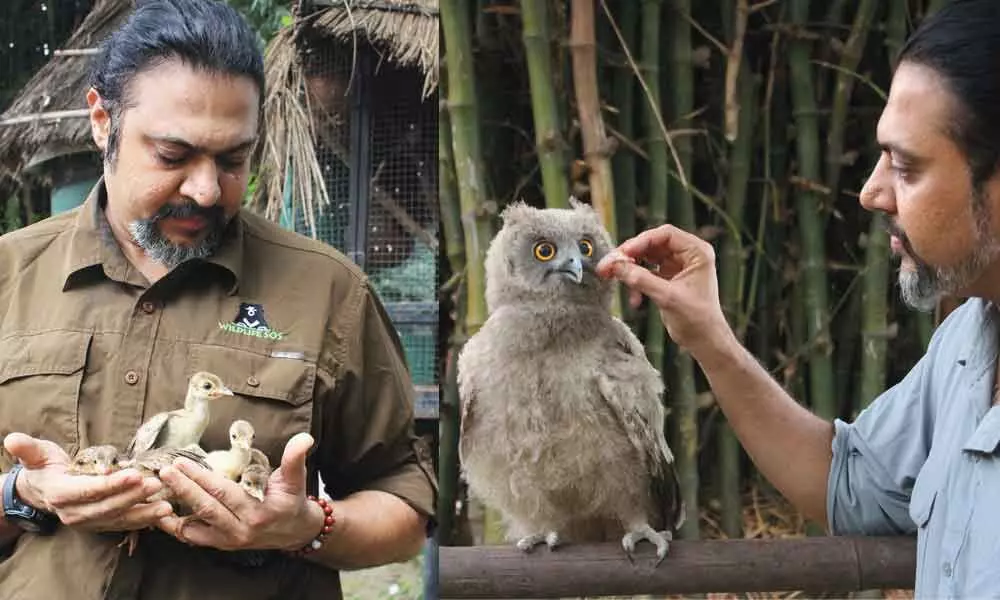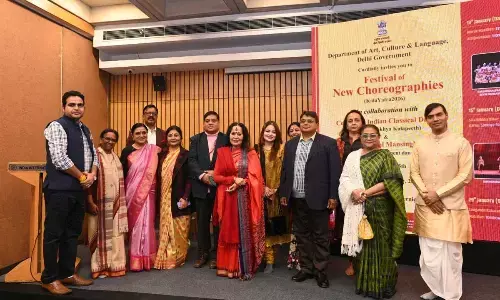Kartick Satyanarayan: A wild passion for animals

Kartick is a member of the IUCN Bear Specialist Group (Sloth Bear Team Expert)
We sensitised people against poaching during lockdown
Bengaluru: He had his first encounter with wildlife as a two-year-old boy. As a student, he had spent many full moon nights atop trees adjutant a water hole in a forest area on the outskirts of Bangalore (now Bengaluru) from where he had the pleasure of watching herds of wild elephants, bison, leopards, bears and other wildlife visiting the water hole.
"I recall spending a lot of time in parks and wooded areas to watch birds, butterflies and animals at every opportunity. The building experience of watching wild animals displaying natural behaviours inspired me to make a vow to myself to protect India's wildlife.
Even as a teenager I was severely addicted to the outdoors and as a student I volunteered with the Karnataka Forest Department and even had the opportunity to accompany the night patrol teams to monitor the forest, protect and conserve the forests and the beautiful creatures that lived in these vanishing forests. As a school student, I would volunteer with the forest department and accompany night patrol teams and also try to rehabilitate birds, snakes etc. I would also use any and every opportunity and excuse to go bird watching and on jungle treks, says Kartick Satyanarayan, co-founder of non-profit wildlife conservation orgainsation 'Wildlife SoS'.
For well over two decades, Kartick undertook several projects to bring an end to the age old brutal practice of 'Dancing Bears' in India, rescued and rehabilitated thousands of animals with his volunteers spread across Karnataka and the rest of the country, saved animals from illegal captivity and poaching and helped abandoned and abused animals. He graduateed in business management from BHS Vijaya College in Bengaluru.
In conversation with The Hans India, Kartick Satyanarayan talks about Wildlife S.O.S he cofounded in 1995 with Geeta Seshamani, the organisation's several initiatives, his passion for animal conseravation and rescue efforts, wildlife laws and much more.
Poachers have no season but did poaching activity witness a rise during the last five months of pandemic induced lockdown. There have been several reports of poaching activity across the country, but specifically in Karnataka. There has been a massive trade in animals and animal parts. What are the most poached animals? What role did Wildlife SOS play in curbing poaching activity during the lockdown period?
The Wildlife SOS anti-poaching unit —'Forest Watch' uses undercover informers to gather intelligence on wildlife traffickers and such transactions and passes on the information to the Wildlife Crime Control Bureau, the Forest Department and the Police who are the authorised agencies to enforce the law and take legal action against such offenders. During lockdown, our team was involved in creating awareness to empower the public using digital and electronic media.
Animal rights activism finds new challenges in India's changing economy as environmental destruction continues unabated. What are the major challenges that wildlife activists face in rescuing animals? There are several laws to protect wildlife, many of them outdated. Is there a need to review the laws? Did the conservation of wildlife fail due to the implementation of laws?
India boasts of one of the best Wildlife protection laws in the world. The Wildlife Protection Act, 1972 is a very visionary law that bans trafficking or poaching of any wild animals covered under various schedules of the act. It also prescribes imprisonment of unto 7 years and a fine for offenders who are convicted under this act thereby making it one of the best protection blankets for wildlife. That being said, the implementation of these laws in India faces a lot of challenges due to public ignorance about wildlife offences, exploding human population and lack of knowledge about wildlife laws and punishment.
The need of the hour is public education. The fact that we have wild tigers, elephants, leopards, bear and a wealth of wildlife living amidst people in one of the most densely populated countries in the world is a sign that there is still hope and if each one of us does the right thing to help protect and conserve wildlife then we can certainly make a difference. Wildlife SOS invites volunteers to come and become a part of the solution. Please send us an email at [email protected] to engage with us Bannerghatta Park area is shrinking.
The Karnataka government is making all efforts to reduce the land in Eco-Sensitive Zone to 181 sqkm from the existing 269 km despite protests from the locals and environmental groups. Several infra projects fall around the Eco-Sensitive Zone which poses a direct threat to the elephant corridor. The Hubballi-Ankola rail project, a railway line through a tiger corridor in Telangana, Etalin hydroelectric power project in Arunachal Pradesh's Dibang Valley, Kutku Mandal dam project in Jharkhand. Does it seem governments are working against wildlife to accommodate mining and real estate interests?
We are aware that it is a challenge faced by every state government to balance the economy, livelihoods and natural resource protection. While there is a need to develop infrastructure , build hospitals, railway lines and roads etc. to help sustain the growing population of India, a sensitive approach balancing protection of forests and well-planned development is the need of the hour. A good example would be all highways passing through, near or adjacent to forest areas must have underpasses and wildlife corridors so wild animals do not suffer fatalities from road accidents and prevent road kills.
How many animals were you able to rescue since you founded Wildlife SOS in 1995? What are the key projects and the core area of your work? What habitat or species are you most concerned about?
We've rescued thousands of animals since we started in 1995, possibly 50,000. We have several projects, including eradicating the illegal practise of dancing bears in India, providing alternative livelihood to Tribal communities engaged in unsustainable exploitation of wildlife, human-wildlife conflict mitigation, specific focus on leopards, bears, elephants and reptiles, wild elephant radio collaring and Early Warning System (EWS) establishment, leopard protection and conservation.
Wildlife SOS was established to make lasting change to protect and conserve India's natural heritage, forest and biodiversity. We actively work towards protecting Indian wildlife, conserving habitat, studying biodiversity, conducting research and creating alternative and sustainable livelihoods for erstwhile communities that depend on wildlife for sustenance.
What conservation work are you most excited about?
I am most excited about practical aspects of wildlife conservation wherein, creating alternative livelihood for communities that were previously involved in poaching and trafficking to wean them away from. Exploitation of wildlife while also helping to improve their standard of living.
Additionally, supporting their children's education and women empowerment. Such a pragmatic and multi-faceted approach towards protection of species while ensuring that the community is involved in participating makes for long-term sustainable conservation success.
The conservation work I am involved in stretches from everyday rescue efforts of wild animals. Wasting with mitigating human-wildlife conflict situations and conservation research. However, I truly feel fulfilled when I see a rescued animal being released back into the wild, in its natural habitat.
I am passionate about every aspect of wildlife conservation— whether it's going out to the field to carry out an elephant or leopard rescue, translocating animals caught in conflict situations, educating the public on conservation issues to conducting research to protect and care for wildlife species.















